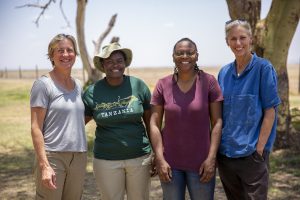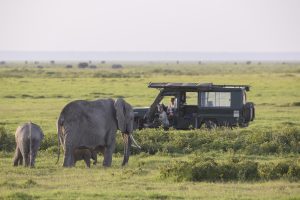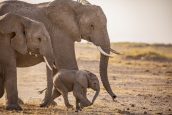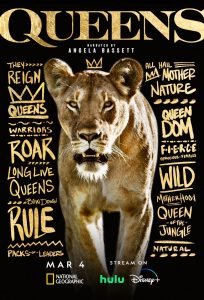
QUEENS Director of Photography Justine Evans, Mentee and Filmmaker Erica Rugabandana, Series Director and Mentee Faith Musembi, and Director of Photography Sophie Darlington | ©2024 National Geographic for Disney / Andrew Thompson
The seven-part nature documentary series QUEENS is now streaming in its entirety on both National Geographic and Disney+. Narrated by Angela Bassett, each episode focuses on matriarchal animal societies in different environments. QUEENS is also primarily made by women filmmakers.
Executive producer Vanessa Berlowitz has been with QUEENS since its inception; Chloë Sarosh is the showrunner and a writer on the project. Berlowitz, an Emmy winner for FROZEN PLANET, co-founded Wildstar Films after working with the BBC’s Natural History Unit for twenty-five years. Sarosh has been a producer on other docuseries, including EARTH FROM SPACE and NATURE’S WEIRDEST EVENTS.
During National Geographic’s portion of the Winter 2024 Television Critics Association (TCA) press tour, Berlowitz and Sarosh sit down together to talk QUEENS.
Berlowitz explains that the series began “with a simple selling conversation, which was, I pitched the idea to a brilliant female exec at Nat Geo, Janet Han Vissering. It was actually the storyline of the opening show, ‘African Queens.’ It was just going to be one film, and it was going to feature the female DPs that are specialists, and known for filming those animals really well. And she was the one that said, ‘Make a whole series. No one’s done this before.’ And I went, ‘Surely they have,’ and we discovered no one had. So, from that moment, once that commission happened, it grew. I recruited Chloe, who was on maternity leave at the time, kind of like, ‘I’m not interested, I’m completely exhausted, I don’t need work at the moment, I just need to be a mum.’ And she was absolutely the woman for the job. And then Chloe helped bring on the rest of the team.”
Sarosh nods.
Berlowitz continues, “And we also brought in two brilliant directors of photography, Sophie Darlington and Justine Evans. Because one of the challenges, we realized, was that we wanted to try and give an opportunity to showcase female talent, but there just weren’t that many women who’d had the opportunity to get to that level that we needed. So, we recruited them, and then they recruited five young, brilliant talents who were mentored through the process of QUEENS, and fledged as fully-formed, brilliant filmmakers themselves.”
While directors often hire and even mentor their directors of photography, it’s unusual for a director of photography to hire and mentor a director. However, this was the case with director of photography Sophie Darlington and episode director Faith Musembi.
Sarosh relates, “With Faith, she had different mentors in different areas of production. So, I spent a lot of time with her, working on editorial, the storytelling. She spent time in the field with Sophie, working on her field craft, and her filming. So, we all worked together on that, which is one of the great joys of this project, is how collaborative it was, what a team we were, and still are.”
She turns and shares a smile with Berlowitz, who adds, “Yeah.”
Sarosh is credited as a writer, but how does one go about scripting a nature documentary? Do the filmmakers look at the footage and then decide how to best put it into narrative form, or do they start with an idea of the narrative they want and then ask the directors and DPs to get the appropriate wildlife footage?
“It’s a bit of both,” says Sarosh. “It’s definitely a process. We start out by working with scientists, and we do a lot of research. And from that, we work out what we the most inspiring, exciting storyline may be, and what we may see, and if we go at the right time of year, and what we might get, and then we write a shooting script from that. Then we go into the field, and either nothing happens, or something completely different happens, or maybe we’re lucky, and we get what we set out to get. So, we pivot and we change. And then we take it into the edit, and it evolves from there as well. So, it’s a constant process.”
The episode “African Queens” focuses on lions and hyenas. How did the makers of QUEENS decide what other animals they wanted to include?
“Well,” Berlowitz replies, “there are sort of ten well-known matriarchal animal societies. We looked through which ones would give us a different balance of types of themes and storylines. The great thing about lions and hyenas that you mention is that there’s a really strong theme of sisterhood in that. We also knew that we wanted to capture the ultimate matriarch, which is the elephant. And then we looked through, and went, to balance this and give a really varied experience of these different female queendoms, we chose a selection, and I worked very closely with Chloe to do that.
“But there are other matriarchal societies out there that we have yet to do, like kangaroos, like lemurs, like most of the insect world. So, there are more to choose from, but we wanted to find some that gave us a sort of variety of landscapes, a variety of creatures that were big and small, and dramatic, and sometimes intimate, but also, more importantly, the themes that they represent around female leadership are quite varied.”
Most people know that ants and bees are matriarchal, but some insects, if people have heard of them all, are not famously female-led. How did the filmmakers even find these species for the episode “Tiny Jungle Queens”?
“We spend a good year researching these stories before we even turn a camera on,” Sarosh says. “So, a lot of it is that deep dive into what the new science is – who’s studying what, what are the stories, what can we even capture on film? What’s realistic, what’s not? I think what I love about that insect episode as well is that perhaps people know that ants are cooperative. But that bee, she is something else. I mean, she is certainly not.”
Both women laugh.

Cinematographer and mentee Erin Ranney films elephants on the RED Gemini and Canon CN20 in QUEENS | ©2024 National Geographic / Oscar Dewhurst
“It was really important for us to show that female leadership isn’t always kind,” Sarosh continues, “and it isn’t always gracious, and it’s not always about sisterhood and resilience and strength. It’s sometimes about being …”
“Ruthless,” Berlowitz supplies.
“Ruthless,” Sarosh agrees. “And we wanted that dramatic ebb and flow.”
What did the women find most surprising or gratifying throughout the course of making QUEENS?
“Every day was something new,” Sarosh responds. “We had so many new things that we filmed. That hyena infanticide in ‘African Queens,’ the death of that baby hyena – we weren’t expecting to film that, and I think audiences will be really grateful that we don’t show exactly what we filmed on that day, because it was brutal. But amazing to have a ringside seat to see that kind of behavior play out. Unbelievable.”
And what would they most like people to know about QUEENS? Berlowitz speaks for herself and Sarosh. “Just know that if they come and watch it, they will find so much that’s fresh and different, and unlike any other natural history show. And it’s for everyone. It’s made through a female lens, but it’s really got storylines that everyone will identify with, that are as dramatic and extremely extraordinary as anything you see in SUCCESSION.”
Related: QUEENS: Cinematographers Justine Evans and Erin Ranney on their new National Geographic miniseries
Follow us on Twitter at ASSIGNMENT X
Like us on Facebook at ASSIGNMENT X
Article Source: Assignment X
Article: Exclusive interview with QUEENS Executive producer Vanessa Berlowitz and showrunner Chloe Sarosh
Related Posts:












